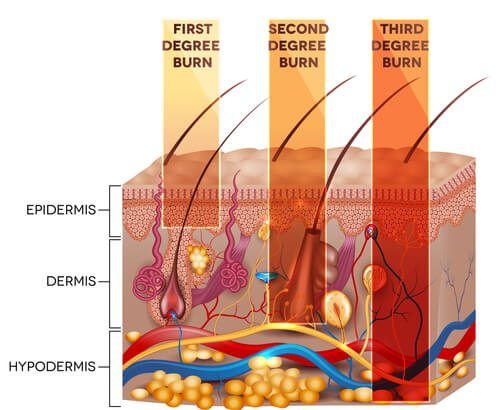Types of Burn Injuries
Read on for information on the different types of burn injuries, what to look for and when you should see a Doctor.
We have all been burned at least once in our life. If you haven’t, consider yourself lucky, as burns can be very painful and sometimes even life-threatening. Learn when to seek medical attention.
Burn injuries are categorized by degree of severity, and there are three types; First-degree, Second-degree, and Third-degree burns. We will talk a little about each type including information on whether you can treat them yourself, or if you should seek advice from your Doctor.
First-Degree Burns
First-degree burns are the least severe of the three types of burn injuries. You may recall a time when you splashed boiling water on your skin while cooking that left behind a small area of inflamed red skin. This was most likely a first-degree burn. Other hallmarks of this type of burn are redness, minor swelling, and pain.
You can usually treat first-degree burns at home on your own. One of the easiest and most effective treatments is to run the affected area under cool water to soothe the pain. Applying antibiotic ointments or aloe vera gel can also be an effective treatment as both are soothing for a painful burn. If the pain is severe, you can also use pain medications such as ibuprofen or acetaminophen. You should never treat any severity of burn with ice, as this can do more harm than good.
Additionally, if the burned area is larger than three inches, or on your face, you may want to have it looked at by your Doctor regardless of severity.
Second-Degree Burns
Second-degree burns can be a little more serious. If you’ve ever burned yourself on an iron while pressing a shirt for work, you may have received one of these types of burn injuries. One of the most recognizable features of a second-degree burn is the blister. The skin bubbles up and swells because the damage has extended beyond the first layer of skin.
This type of burn can be much more painful and usually takes longer to heal; sometimes as long as two weeks. The blister may ‘pop,’ but should eventually scab over. In some severe cases, skin grafting may be required. With second-degree burns, it is always a good idea to have a Doctor check it out. If your Doctor gives you the ‘OK,’ you can treat it at home. Self-treatment is much the same as for a first-degree burn. Remember, no ice!
Third-Degree Burns
Third-degree burns are the most severe. With this type of burn, the damage can be so extensive that there is no pain. This is usually caused by damage to the nerve endings in the skin. Get to a Doctor for third-degree burns, as left untreated, permanent scarring can occur. Third-degree burns penetrate all layers of the skin.
If you believe you may have received a third-degree burn, call 911 right away. Prompt medical treatment could save your life. While you are awaiting medical attention keep the wound above the level of your heart and make sure no clothing is stuck to the damaged area. Due to the severity, this type of burn usually requires surgery.
Other Things to Consider
As with all injuries, there can be complications. These issues, though not unheard of, are uncommon with first-degree or second-degree burns. Some of the complications that may arise with a third-degree burn are very serious. Blood loss or shock can occur and in some cases, could be fatal.
All three severity levels can carry the risk of infection due to broken skin. Also, tetanus is a concern, so be sure you are always up to date on that shot! Every ten years is the current recommendation.
If you are burned in an industrial accident, by either chemicals or electricity, it is always recommended to seek immediate medical attention regardless of burn severity. There are other considerations that must be addressed because chemicals can have an effect on the body in other ways, even if skin damage is only superficial.
An Ounce of Prevention…
No one can prevent every accident. We are human after all, and things happen. What we can do is minimize our risk by being proactive. Here are some simple things you can do.
When you are cooking, make sure the kids aren’t underfoot and keep those handles turned in and away from curious hands. Make sure you have fire extinguishers placed strategically throughout your home. Other things you can do, like keeping the temperature on your water heater below 120 degrees and measuring the bath water temperature for those little ones, can go a long way in preventing injury.
Burns can be a catastrophic injury. If you are burned in a workplace incident or due to the negligence of others, be sure and reach out to your Boca Raton Burn Injury Lawyers!




